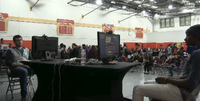Setup
A setup refers to a "station" that can allow two or more players to play a game, especially within tournaments. At its core, a setup requires a console and a television set on which to display the game. The specifics for each game, however, can change what may be required for a setup. At most tournaments, TOs will give an incentive for contestants to bring in setups, often by offering a discount to the venue fee or sometimes waiving it entirely.
Universal requirements
Tournaments for Smash 64, Melee, Brawl, and Project M prefer the use of a cathode ray tube television, owing to concerns over input lag that modern televisions can introduce, especially in tandem with composite video cables used for the Nintendo 64, Nintendo GameCube, and the Nintendo Wii. However, as Smash 4 does not support 4:3 ratios, the use of widescreen televisions is accepted in the tournament scene, though such TVs may require the use of a "Game Mode" or they should be considered of "high quality" by the TOs.
In a majority of tournaments, both players sit side-by-side, sharing the same television set; some tournaments, however, may use more sophisticated setups where all players have their own screen.
All setups are required to have all characters and all relevant, legal stages unlocked and available for use, whether from save data or by using cheat devices. In a majority of cases, the original console and game are used, though emulators have sometimes seen use in tournaments.
While all the games can be hacked or modded to some degree, any hacks that modify the gameplay of the base game are not allowed, as they can create discrepancies in how players play the games. Although a number of gameplay hacks may be considered beneficial, such as those that remove tripping in Brawl, the logistics issues that arise from necessitating all setups to use the same hacks makes such tournaments infeasible to run. Exceptions are made for tournaments based around gameplay mods, such as Project M. Mods that only modify the appearance or music of the game are considered acceptable, provided such modifications are not considered distracting to players, such as by playing loud, distracting music or by radically changing the appearance of characters or stages.
Controllers are not required for a setup, as players are expected to bring their own controller.
Game-specific considerations
Super Smash Bros.
While the use of a Nintendo 64 is common at Smash 64 tournaments, setups that use emulators are also widely accepted in tournaments, owing to the popularity of such emulators for playing Smash 64 outside of tournaments. The Virtual Console release of Smash 64 is rarely used because of concerns over frame skipping.
Smash 64 tournaments may require an external clock or stopwatch to be present alongside a setup, as Smash 64 cannot allow for a time limit on stock matches. The external clock allows TOs to gauge when the match ends.
Since the release of 19XXTE in 2015, using the hack on setups has been allowed, as it features a number of enhancements that can improve how tournaments are run, most notably by adding a match timer to stock matches.
Super Smash Bros. Melee
No specific requirements beyond a television and a console are required for setups involving Melee. Tournaments generally prefer the use of a GameCube, as it is easier to startup Melee on it versus a Wii, though tournaments rarely ever ban the use of the Wii; in tournaments where Melee is played alongside Brawl or one of its gameplay mods, the Wii is then sometimes preferred, owing to its backwards compatibility.
Although several versions of Melee's NTSC release exist, tournaments generally do not regulate which version of Melee should be used, as the gameplay changes are generally not considered significant enough to warrant such a restriction, as well as the fact that version 1.2 is the most common revision of the game. That said, the regional version of Melee should match the region of the tournament; North American tournaments only use the NTSC release, while European tournaments only use the PAL release. As the PAL release contains more significant gameplay changes compared to the NTSC release, particularly regarding characters such as Fox and Sheik, mixing of the two regional variants of the game is forbidden.
Consoles which feature variants of 20XX are allowed in tournaments, provided all of its available gameplay hacks are disabled.
Super Smash Bros. Brawl
No specific requirements beyond a television and a console are required for setups involving Brawl and its gameplay mods.
Tournaments for Brawl and its gameplay mods, such as Project M, strictly use the Wii over the Wii U, owing to the presence of controller ports for Nintendo GameCube controllers that a majority of players use.
Super Smash Bros. 4
All Smash 4 tournaments require that a setup have a Nintendo GameCube adapter, owing to the ubiquity of the Nintendo GameCube controller at Smash 4 tournaments.
When the Official Custom Moveset Project was still active, setups were required to have all custom moves unlocked, as well as have all legal movesets from the project on their Wii U, often by "tethering" a separate Nintendo 3DS to the console.

